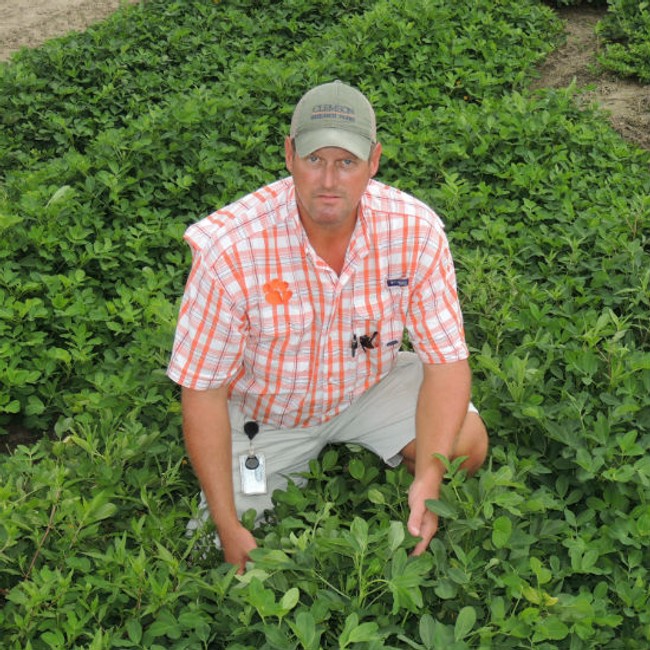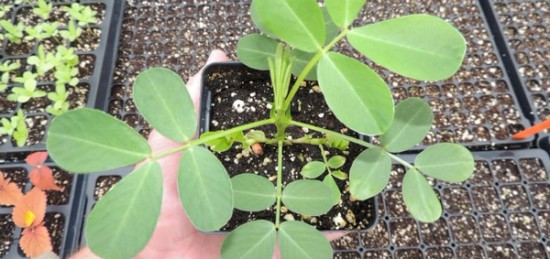The Carolina African Runner peanut re-emerges, giving farmers and chefs a new culinary adventure.
At Clemson University’s Coastal Research and Education Lab, horticulturist Dr. Brian Ward stands for hours at a time carefully hand sorting, shelling and cleaning a small, distinctive and somewhat celebrated peanut known as the Carolina African Runner peanut. And like most rare finds, it has a story behind it.
“The Carolina African peanut is so tiny that when it runs through a shelling machine, only about 70% will make it into a pile of good seed, then the sheller has to throw the rest out,” Ward said.

Horticulturist Dr. Brian Ward, Clemson University
This spring, Ward is bent on safeguarding as many good seeds as possible to provide farmers with enough seeds to sustain the heirloom peanut. So, he’s hand-shelling that last 30%.
“It takes about six of us cleaning and separating to get about 20 extra pounds of seed in a day,” Ward said.
The necessary tedium to ensure the peanuts are edible helps explain one reason food historians, chefs and artisans assumed this peanut was extinct.
Once Upon a Time
Brought to the port of Charleston in 1690 by African slaves, the re-emerged Carolina African Runner peanut is known as the first peanut planted in the American colonies. It is denser, sweeter, smaller and had a higher oil content than the peanuts we eat today.
Originally, its culinary uses were influenced by West African practices: the peanuts were boiled, ground into meal, candied, mashed or made into a hot beverage, roasted and pressed into oil.
In the 1800s, taste buds in the northern cities preferred roasted peanuts, and street and ballpark vendors popularized the larger Virginia snack peanuts. The public quickly deemed Virginias as America’s “eating” peanut.
When the boll weevil threatened to wipe out the South’s cotton crop in the 1910s, and cottonseed was unavailable for cottonseed oil production, the Carolina African peanut saw a brief resurgence because of its high oil content. But by the 1930s, the peanut’s small size created additional work at harvest and field workers complained. It was vulnerable to certain diseases in the field, which made it unreliable for growers who needed to produce larger crops.
Historians believe the last commercial crops of Carolina African peanuts date from the late 1920s, and it was believed to be extinct by the end of the 1950s.
Whether by fate or foresight, a mere 40 Carolina African Runner Peanut seeds were carefully tucked away in cold storage by plant breeders at North Carolina State University (NCSU).
A Quest Begins
Some 60 years later, food historian Dr. David Shields of the Carolina Gold Rice Foundation, along with Southern food artisans, chefs and financial partners, began a quest to recreate a historic Southern menu. Shields searched through colonial ship manifests and early papers to find proof that in 1690 peanut seeds arrived on our shores. Five years later, a phone call to NCSU’s breeding facility produced the ancestral peanut.
“They gave me half of the entire collection,” Ward said. “They just told me it was ‘special seed’ and to take good care of it. It wasn’t until harvest that I learned these were the original Carolina African Runner peanuts everybody thought were extinct."
In 2013, Ward planted the seeds next to his field lab to watch them closely, and twelve plants made it. The next season, Ward and a South Carolina farmer Nat Bradford multiplied the seeds to 1,200 plants. Other farmers got involved and the first commercial crop of 15 million peanuts was harvested in 2016.
Then, bad weather struck the Southeastern growing regions for two seasons, hitting the heirloom peanut fields hard. Flooding and a GPS error greatly reduced the yield and Ward is growing out a smaller two-acre field -- “not for selling, but just for seed.”
The Most “Peanutty” of Peanuts
“The best part of this discovery is it has cultural and historical significance,” Ward said. “The flavor is ‘wow,’ ‘bam!’ The aroma is more potent than our traditional peanuts today.”
Chef Forrest Parker of the Old Village Post House in Mount Pleasant, South Carolina was the first chef who received the peanuts. He calls them “the most peanutty peanut of peanuts,” Ward said.
Nat Bradford, an artisan farmer in Seneca, South Carolina, and was given enough of the revived peanut seeds for three-fourths of an acre.
“The story behind it is fascinating to me,” Bradford said, “Once you acquire the seed, it’s precious and you’re a steward of it. You don’t want to store it, but to put it back into use, to reproduce it and discover the market potential.”
This year, he’s planting five acres and “making it successful enough to be sustainable and profitable,” Bradford said. “I’ve never had a peanut like it.”
Bradford admits the price is high right now ($20 per pound) but he said it’s because “there’s so much work involved in cleaning, sorting and shelling. I’ve spent most of my winter evenings with my kids cleaning, picking out debris, shelling them—it’s a labor of love.”
Reawakening an Original Superfood
Ward sees market potential for the Carolina African peanut. He’s had dozens of farmers interested in growing it and shipped it to 50 or 60 artisan farmers so far. Several chefs throughout South Carolina and Georgia are experimenting with different culinary uses, such as making peanut hummus and peanut brittle or boiled peanuts.
As Bradford said, “The difference is the flavor. I want chefs to find new ways to use them, so more people can experience their flavor. It is uniquely amazing.”
One peanut butter company, Good Spread, is interested in the heirloom peanut because it reflects their mission of “fighting global malnutrition and using our footprint to protect and enrich the environment and communities we impact,” said Robbie Vitrano, founder and owner of Good Spread. Each jar the company sells provides one packet of peanut butter-based Ready-to-Use-Therapeutic Food (RUTF) to treat malnourished children worldwide.
Plus, Vittrano is working on a peanut butter with the heirloom peanut. But why the Carolina African peanut?
“We love the cultural narrative of the artisan peanut, and the opportunity to use agricultural practices that protect and improve the environment," Vittrano said. "Peanuts are an original superfood—we believe one way we’ll reawaken people to that is with products that have both an original story and bring new flavors and tastes to our customers.”
That’s why many believe the story of America’s original peanut is just beginning.
